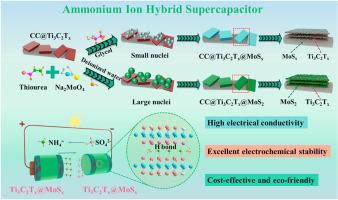非晶MoSx纳米粒子与Ti3C2Tx MXene层协同集成用于高性能铵离子超级电容器
IF 7.9
2区 工程技术
Q1 CHEMISTRY, PHYSICAL
引用次数: 0
摘要
非金属载流子在电化学储能装置中的引入,在与水电解质的相容性方面具有显著的优势。然而,与其他储能技术相比,用于这些载体的合适电极材料的开发仍然相对较慢。在这里,无定形的MoSx纳米颗粒在Ti3C2Tx纳米片表面原位生长,作为氨离子超级电容器的宿主材料。Ti3C2Tx纳米片为MoSx提供了具有大比表面积的生长环境。异质结的协同效应提高了复合材料的比容量。无定形MoSx纳米颗粒通过乙二醇溶剂策略形成。与MoS2相比,无定形MoSx具有丰富的缺陷和硫空位,有利于NH4+的快速插入/脱插入,促进氢键的形成。具体而言,Ti3C2Tx@MoSx在1 a·g−1时提供196.94 mAh·g−1的高比容量,并且在10000次循环后保持其初始比容量的91.01%。在500.81 W·kg - 1时,组装的对称超级电容器的能量密度达到50.08 Wh·kg - 1,循环稳定性良好。这项工作突出了复合材料工程在优化氨离子超级电容器性能方面的广阔潜力,揭示了其在提高储能效率和性能稳定性方面的重要作用。本文章由计算机程序翻译,如有差异,请以英文原文为准。

Synergistic integration of amorphous MoSx nanoparticles with Ti3C2Tx MXene layers for high-performance ammonium-ion supercapacitors
The introduction of non-metallic charge carriers in electrochemical energy storage devices offers a significant advantage in compatibility with aqueous electrolytes. However, the development of suitable electrode materials for these carriers remains comparatively slower than other energy storage technologies. Here, the amorphous MoSx nanoparticles grow in situ on the surface of Ti3C2Tx nanosheets as host material for ammonium-ion supercapacitors. The Ti3C2Tx nanosheets provide a growth environment with large specific surface area for MoSx. The synergistic effect of heterojunction enhances the specific capacity of the composite. Amorphous MoSx nanoparticles form via an ethylene glycol solvent strategy. Compared with MoS2, the amorphous MoSx exhibits abundant defects and sulfur vacancies, which facilitate rapid NH4+ insertion/de-insertion and promote hydrogen bond formation. Specifically, the Ti3C2Tx@MoSx delivers a high specific capacity of 196.94 mAh·g−1 at 1 A·g−1 and retains 91.01 % of its initial specific capacity after 10000 cycles. Moreover, the assembled symmetric supercapacitor achieves energy density of 50.08 Wh·kg−1 at 500.81 W·kg−1 and satisfactory cyclic stability. This work highlights the broad potential of composite engineering in optimizing the performance of ammonium-ion supercapacitor and reveals its important role in improving energy storage efficiency and performance stability.
求助全文
通过发布文献求助,成功后即可免费获取论文全文。
去求助
来源期刊

Journal of Power Sources
工程技术-电化学
CiteScore
16.40
自引率
6.50%
发文量
1249
审稿时长
36 days
期刊介绍:
The Journal of Power Sources is a publication catering to researchers and technologists interested in various aspects of the science, technology, and applications of electrochemical power sources. It covers original research and reviews on primary and secondary batteries, fuel cells, supercapacitors, and photo-electrochemical cells.
Topics considered include the research, development and applications of nanomaterials and novel componentry for these devices. Examples of applications of these electrochemical power sources include:
• Portable electronics
• Electric and Hybrid Electric Vehicles
• Uninterruptible Power Supply (UPS) systems
• Storage of renewable energy
• Satellites and deep space probes
• Boats and ships, drones and aircrafts
• Wearable energy storage systems
 求助内容:
求助内容: 应助结果提醒方式:
应助结果提醒方式:


